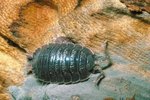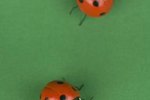
Pill bugs are known by a number of common names, including roly-polies, woodlice and potato bugs. They are commonly confused with sow bugs, but pill bugs can roll into balls when disturbed, whereas sow bugs cannot. Children love finding them in the yard, and reptile keepers like using them as a part of a cleanup crew in reptile habitats and feeders. Pill bugs are natural decomposers. You can easily raise them in captivity for composting, for reptile feeders, for terrarium cleanup or solely for observation.
Natural Habitat
Pill bugs can be found in just about any humid area. They thrive in damp locations such as in compost piles, under leaf litter, in pine straw, behind bark and in other organic landscaping materials. It's not uncommon to find large populations under logs, potted plants and rubble.
Housing
You can house pill bugs in a cardboard box, but eventually the moist substrate will cause the box to deteriorate. A plastic tub or glass aquarium works better for housing pill bugs. Use about an inch of moist soil, peat moss or humus; use a substrate that will hold humidity. On top of the substrate, you'll want to place a thin layer of leaf litter or bark and use a chunk of wood or bark as a cover.
Humidity
Pill bugs are quite simple to maintain. You don't need to add additional heating, but you do need to ensure high humidity. Mist the enclosure daily to keep the substrate moist, but don't saturate the substrate. A humidity gauge will help you monitor the humidity level; you want to maintain it above 75 percent. At 85 percent, pill bugs can absorb the water vapor from the surroundings and keep hydrated. Without proper humidity, pill bugs won't survive.
Lighting
Pill bugs are nocturnal, so you don't have to add any specialized UV lighting. If you want to create a natural day and night scenario, you can add a clamp light with a regular coil light bulb. Set up a timer so the light turns off after about 10 to 12 hours of daylight.
Diet
In the wild, pill bugs eat mostly decomposing vegetation -- vegetables, fruits, plants, grasses and weeds. When raising pill bugs in captivity, you can feed them fish flakes, apples, carrots, potatoes, lettuces and wild leaf litter. After preparing dinner or dessert, you can throw your vegetable scraps in the pill bug habitat. You don't necessarily have to offer rotting food, but pill bugs will definitely devour vegetation that has sat out a few days and turned soft. Do not offer food that has molded.
Maintain the Habitat
Keeping pill bugs is fairly simple. The key to maintaining the habitat is ensuring that mold doesn't grow. Because the habitat needs to be kept moist, you want to remove uneaten food so it doesn't mold. Otherwise, you don't have thoroughly clean the habitat; the pill bugs will clean after themselves.
References
Photo Credits
-
Jupiterimages/Photos.com/Getty Images




